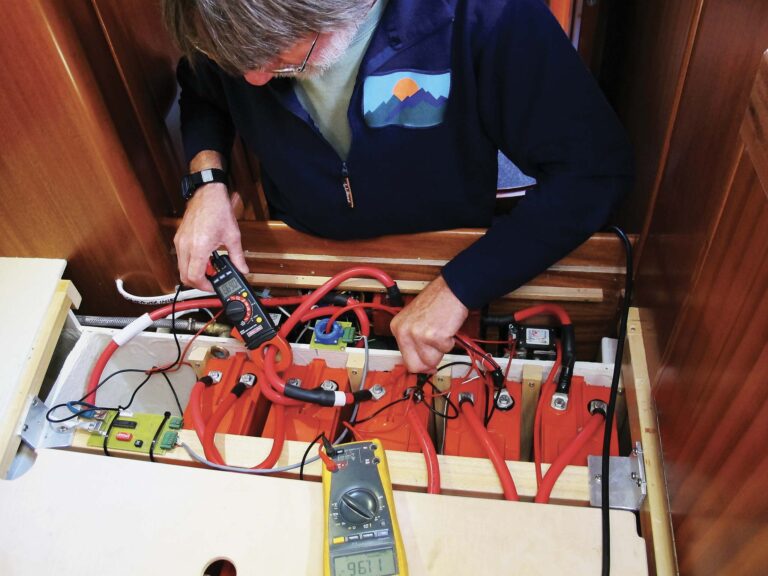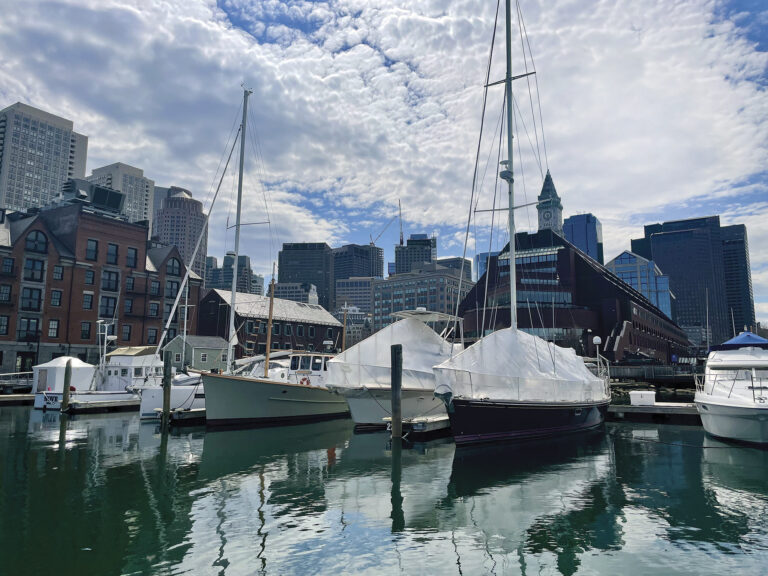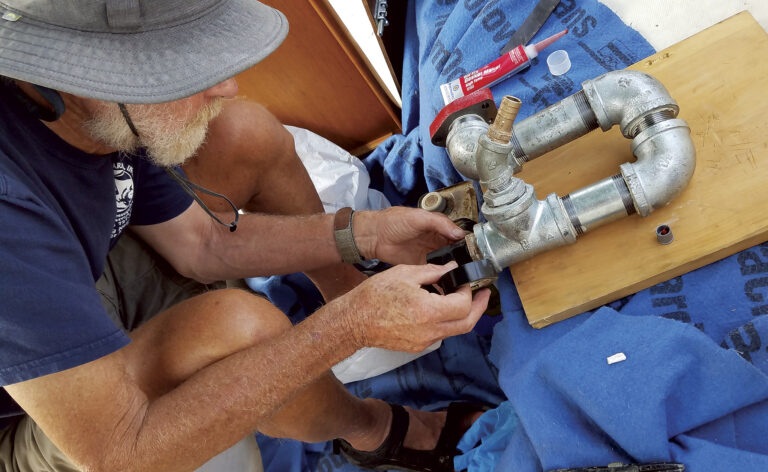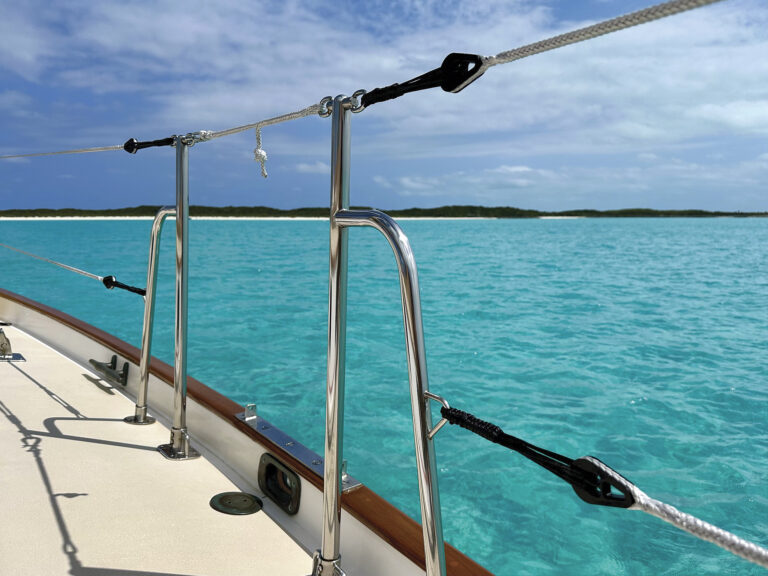Professional applicators know that the preparation and priming stages of any paint job (covered in last month’s issue) are the most important and will take 80 percent of the time spent on a paint job. But they also know that what they get paid for is the finish. Once you have completed the preparation and priming stages, the next step is the application of the paint itself. This is where all of your hard work pays off.
Sometimes choosing the finish paint is the hardest part of the entire paint process, not only because of the various types of paints to consider, but because of the equipment needed, whether or not you have a place to perform the work, and whether you have the necessary skills. Planning the paint job is just as important as applying the paint itself, so make sure you contact the paint manufacturer and get all the information that you can in advance so you will have the confidence to do the job right.
Which Finish?
There are several types of paints used to paint boats, which tends to become confusing. For most sailors, there are essentially only two types to choose from—one-part and two-part paints. However, within these groups there are differences between the types of resins used, the application methods and the longevity of the coatings.
One-Part paints
When it comes to one-part paints, there are three main options out there. The first employs alkyd resins, which are sometimes referred to as enamels. A typical alkyd paint consists of a resin that has been modified by an oil such as tung, linseed or castor oil, to form the coating film. Solvents, driers and pigments are added to make it easier to apply, dry properly and to provide color and hide (i.e. the ability to obscure the surface they are covering). These paints were developed in the 1920s and are still in use. They have a good gloss and hide, and are easy to apply. However, they do not have the longevity of more modern coatings and will need to be recoated sooner.
[advertisement]Silicon-alkyd resins, on the other hand, are alkyd resins that have been modified with silicon to add longevity. They were originally developed to be used as maintenance coatings on steel and concrete but quickly found a use on boats because they provided a finish with greater longevity and a higher gloss than simple alkyds. Silicon-alkyd resins are easy to apply and have good hide, but they are more expensive than straight alkyds.
Finally, urethane-modified alkyds, or one-part polyurethanes, are alkyd resins that have been modified with urethane resin to provide better durability and higher gloss, while still providing the ease of use of a straight alkyd. These are currently the most used type of single-part paints, having surpassed silicone-alkyds over the years. Urethane-modified alkyds are easy to use, provide good hide and provide the best durability of a single-part product.
Two-Part paints
There are many types of two-part finishes, although two-part polyurethanes are the most common. Much like epoxy and single-part paints, two-part paints use a curing agent to gain extra hardness and durability. Two-part polyurethanes are more difficult to apply than single-part paints and are more sensitive to temperature and humidity, but they have the best durability and abrasion resistance along with the highest gloss levels. They also maintain their color and gloss level longer than single-part paints.
There are two main types of polyurethanes used in the marine industry—acrylic and polyester polyurethanes—and there are advantages and disadvantages to both. Both have long lasting color and gloss retention. However, acrylics dry faster, and they can be buffed and repaired in case of a problem in application (or if you happen to bump into the dock and scratch the surface). Also, due to the speed with which they dry, acrylics can only be sprayed. Polyester polyurethanes dry slower, which means they can be brushed as well as sprayed. Polyesters also have a harder, more scratch-resistant finish, but they generally can’t be repaired or buffed like the acrylics. Finally, they require less maintenance and have better chemical resistance.
Applying the Finish
The first thing you want to do before applying any paint is read the instructions carefully. If there is something you don’t understand, contact the manufacturer and ask; paint companies would much rather help you get a good result than try to determine how to fix a problem. Next, figure out how much material and what supplies are needed. Determine the area to be painted and divide by the coverage recommendation on the label. You will have to figure in a loss factor, which is usually 10 percent for brushing or rolling and 25 to 30 percent for spray.
Make sure that when mixing your paint you pay careful attention to the manufacturers instructions: too much thinner and your paint will run; too little and it won’t spread properly.
[advertisement]Try to make sure that the finish you buy is all from the same batch. Batch numbers are usually printed on the lid of the can. If you must purchase paint from different batches, open all the cans and mix them together before starting. Painting professionals call this “boxing” the paint. Some paint must be thinned prior to the application, and some will need to be thinned only when environmental conditions make it necessary. Be sure to purchase the recommended thinner when you purchase the paint.
Rolling and Tipping
The most common method for application is the “roll and tip” method. This is where the paint is applied to the surface using a roller and then “tipped off” with a brush to spread the paint and to remove the roller marks. This is best achieved by having two people working shoulder to shoulder. One applies the paint by roller in vertical stripes from as wide as the roller to about 1-foot wide. The goal is to keep a small wet edge on the paint stripe so that the stripes can be tipped off and blend together more easily. To minimize brush marks, hold the brush at a 45-degree angle and use a light touch on the brush—the objective is to remove the roller stipple and other marks, not to apply a heavy coat.
If you do not have a second person to do the tipping off, work with smaller vertical stripes to ensure you maintain a wet edge. The final stroke with the brush should be from sheer to boot top, lifting the brush off the job when you hit the line where the boot top is taped off. If you begin to tip off, or lift the brush in the wet paint, you will find that it will leave a slight mark that you can see when the paint dries.
There are two types of rollers used when applying paint by the “brush and roll” method, and both work well. The first is a 7in, high-density foam roller with a 1/8in nap that is greenish yellow in color. The other is referred to a “hot dog roller,” made of a high-density white foam. You will also a need a top-quality brush, such as a badger hair or China bristle brush with long flexible bristles and a chiseled tip. When applying by brush, use the largest brush you feel comfortable with.
Spraying
The other way to apply a finish is with a sprayer. This method is usually left to the professionals for a number of reasons, including the fact that the equipment can be expensive, finding a proper place to do the spraying can be difficult, and you need to have the proper Personal Protective Equipment (PPE). Still, spray application can be done by do-it–yourselfers with some practice, patience and a little knowledge. Note that all of the coatings mentioned in this article can be sprayed. Also note that the single-part products require different application techniques than the two-part coatings. For example, with a single-part paint only one coat can be applied per day, but with two-part coatings you will be able to get three coats on without sanding.
[advertisement]When spraying two-part polyurethanes it is extremely important that you use the correct protective equipment. This will include a Tyvek suit, gloves and, most importantly, a properly fitted respirator. Read and follow the health and safety recommendations on the MSDS and the label. These warnings are written for the professional user who will come into contact with the paint on a regular basis, but they will also help keep the casual user safe.
Topcoats can be applied with gravity cup, siphon cup or pressure pot spray guns, which are all just what they seem to be—gravity cup guns feed the paint into the gun from the top, where it is atomized; siphon cup guns position the cup underneath the nozzle and the paint is pulled by suction to the tip where it is atomized; and pressure pot guns have two air-lines, one of which runs to the pot where it pushes the paint to the tip and one which runs to the tip where it atomizes the paint. Professionals will use all three for the finish, but the pressure pot is most commonly used.
When spraying paint there will be a lot of overspray that floats around and can settle on other objects, so it is best to work in an enclosed area or, if possible, tent the boat. If you must work outside, pick an area that is far removed from other boats, buildings or cars. If you are going to attempt spray application make sure that you have the compressor and spray guns required and the correct nozzles and needles for each.
Ideal Conditions
Ideally, it is best to paint when the temperature is between 60 and 80 degrees Fahrenheit with low humidity. If you have to work outside try to paint as early in the morning as possible as soon as the dew has dried from the surface. The surface temperature at application should be at least 5 degrees above the dew point. If you are working outside it is hard not to paint in direct sunlight, but if you have to the surface must stay below 105 degrees Fahrenheit. Applying paint to a hot surface leads to poor flow, which results in an orange peel finish or solvent pop.
Keep in mind that the gunwale on a 45ft boat will be 12 to 15 feet off the ground, and while you can work from ladders, scaffolding would provide the safest and most comfortable environment in which to work. Once topcoat painting is complete, it should be kept free from moisture for at least 24 hours, as high humidity will result in under-curing and loss of gloss. A further seven to 10 days should be allowed for full curing to take place. Only after that amount of time will the finish achieve its maximum resistance to abrasion. Particular care should be taken not to lift a boat in slings before the paint has fully cured.
Finish the Job
You can paint your boat yourself. While it is not easy, it is far from impossible. If you’re not happy with the results, simply sand it back and have a professional apply the topcoat. At least you’ve done the preparation work, and it’s the preparation work that takes the most amount of time and costs the most money. If you don’t think you’re up for the final coat yourself, doing the prep work on your own and having a professional apply the final coat will get you an end result that can be spectacular and a source of pride for years to come.
Tools for the Job: what you need to apply the finish coat yourself
30ft Sailboat waterline to gunwale will require approximately:
1 gal finish
45ft sailboat waterline to gunwale will approximately require:
2½ gals finish
Supply List
Two-part professional polyurethane spray finishes
Topside finish $20–$300/gal
Two-part polyurethane finishes
$70/qt–$125/half gal
Thinners for the above $25/qt–$46/gal
One-part finishes
$22–$40/qt
$80–$120/gal
Thinners for the above $12/qt–$42/gal
Tyvek suits $6–$12
Gloves $12/box
Respirators $14–$400
Painting Supplies
Sandpaper
Masking tape ($6–$30 per roll)
Mixing pails
Stirring sticks
Wipe down rags
Tack cloths
Paint strainers
ADVERTISEMENT
Spray Technique
Spray technique is not the easiest thing to master, and the best way to improve your application technique is to practice. I am not by any stretch of the imagination a good spray applicator, but here are some things I’ve learned that work for me.
1. As you squeeze the trigger of the spray gun the air starts pumping, and as you keep squeezing the paint will finally get to the tip. Getting used to the rhythm of when to start the air and when to start the paint takes some practice.
2. Use your wrist rather than your elbow as the pivot point when moving the gun. If you move the gun with your wrist locked the gun moves in an arc and more paint is applied in the middle of the arc than at the ends. Using your wrist as the pivot point will help keep the spray tip the same distance from the surface and you get a more even application of the paint.
3. Get a couple of 4-by-8-ft sheets of Masonite that are finished on one side to practice on. (You can find these at most major hardware stores.) They can be cut into 4-by-4-ft pieces, and they are inexpensive enough that you can throw them away when the job is completed. Set a couple of pieces next to the boat to make sure you get uniform conditions on the hull. When the paint is mixed properly spray it on the Masonite and watch the flow of the paint. If it stops too quickly you can add thinner, or if it runs or sags you may be applying the coating too heavily. In any case, it is better to work out the problems on the test panel rather than on the boat.
4. One good suggestion is to go online and search out some application videos (sites like YouTube can be a great source). Ask questions of applicators manufacturers and of the paint companies.









